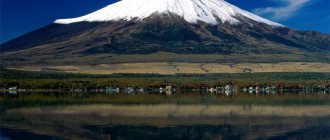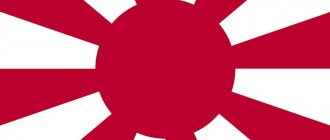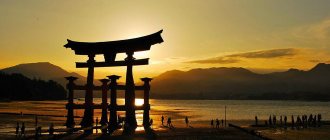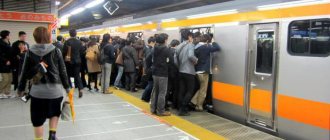So, we have already shared information that visas to Japan are free and not difficult to obtain even in the regions
.
We started calculating “How much does a trip to Japan cost?
”
Today we want to tell you how you can plan your travel route so that it is interesting, varied and does not cost like a “flight into space”. • What does the Japan Rail Pass cover? • How to buy and order a voucher • How to get a JR PASS card • How to use the travel card • Price of the travel card. Options • We calculate the cost of our route. JR PASS Calculator • Important information about the JR Pass • Japan Railways train schedule. How to search for flights for an itinerary
.
We love to travel in rented cars
. But for a trip to Japan we are not considering this option. Why? The main difficulty is that the Japanese do not want to recognize our rights. And we are talking, of course, not about Russian plastic, but about an IDP (International Driver's License) folded into a book, recognized in all countries that have signed the Vienna Convention. The problem is that the Japanese only agree to the Geneva Convention.
To drive a car in Japan, you need to have your IDP translated into Japanese and pass a traffic and driving test.
buses to travel between cities
or trains. Today we will “move around” on Shinkansen high-speed trains and JR JR trains. Therefore, you need to first understand this type of transport. And then we will build a route Tokyo-Kyoto-Nara-Osaka-Himeji-Hiroshima-Itsukushima-Tokyo. We will tell you about the attractions of these places next time. Today our goal is to check whether the JR Pass card really allows you to save money. .
Japan Rail Pass. What does it cover?
The pass is valid for almost all JR and Shinkansen trains.
— On N`ex — express from Narita airport
.
The first area where the pass may be useful to you is moving from Narita Airport to Tokyo on the N'ex
. Let’s immediately check how much a travel ticket costs if you buy it separately.
Of course, at this stage there are alternative travel options. For example, transfer by bus for $28. We will return to it in the section describing the purchase of a travel card, since you can buy a transfer and a travel card right away. Why buy a transfer if you buy a pass? Read the article and you will understand everything!
— For travel on trains in Tokyo
.
In Tokyo, the Yamanote Line allows you to use your pass to access popular areas. Yurakucho Station is Ginza. The rest of the station names speak for themselves.
— Travel in cities by bus
.
The pass applies to buses (not intercity) of the JR group - local bus lines
:
It is also valid for some of JR's bus routes (Sapporo-Otaru; Morioka-Hirosaki; Tokyo-Nagoya, Kyoto, Osaka, Tsukuba Center; Nagoya-Kyoto, Osaka; Osaka-Tsuyama, Kasai Flower Center)
— Travel between cities on Shinkansen trains
.
There are restrictions on travel between Japanese cities on high-speed trains. Mizuho and Nozomi trains are excluded - the pass is not valid for them.
The Nozomi bullet train travels faster than its JR counterparts because it makes fewer stops. It covers the Tokyo-Kyoto distance in two hours and fifteen minutes. The Hikari Shinkansen (covered by the pass) takes 25 minutes longer.
Different types of trains differ in departure frequency. Nozomi walk every ten minutes. Hakari - in half an hour.
The Mizuho Shinkansen runs west from Osaka.
— For travel between cities on regular trains
.
If the train is from the JR group, then if you have a pass, feel free to board it without a ticket.
The map below shows that JR's railways cover a very large area.
Railway map
Where the JR Pass is valid can be found by following
the link
.
If the JR line uses part of the tracks of other railway companies, then you need to pay extra for this section.
— On the ferry to Miyajima Island — JR Miyajima
. .
Characteristics of the railway in Japan
Accuracy
Japanese trains are said to be very reliable when compared to trains from other countries. Shunzo MIYAWAKI, a travel writer, points out that the large number of operational trains and their precision are what Japan's railways pride themselves on in the modern world. In fact, there is a wonderful story about some foreign railway officials who visited Japan; they received a pocket watch from the Japanese employees at the station and checked the train's arrival time, and when they saw that the train arrived at the station on time to the second, they said, "Crazy!" By the way, there are some documents introducing Japanese people to the sense of time, in which, although most foreign railways consider a delay of 5 to 15 minutes to be punctual (even for high-speed railways),
Large number of operating trains: In Japan, a densely populated country, the number of operating trains naturally tends to increase, but at the same time, a slight lag of a train may affect other connecting trains; therefore, punctuality was inevitable.
Complexity of the Rail Network: Japan is one of the countries with the most sophisticated rail network in the world, if not as good as some countries such as Switzerland. Trains often connect with each other at a hub station and sometimes make connections and disconnections. In this case, a slight delay in a train can also cause a greater delay in other connecting trains and hence high punctuality is required.
Human Capacity: Many employees and workers work hard to maintain accurate train schedules and thus solve the problem at the local level even when there are disruptions in the schedule. Japanese trains would never have been able to maintain punctuality without their inventive attempts and efforts. Many influential people such as Koki YUKI, who is called the "god of train traffic", worked hard to maintain the punctuality of the railways in Japan, leading to the maintenance of today's impeccable punctuality.
Large volume of passenger traffic
Passenger traffic on Japan's railways is high, especially commuter trains on main lines in the Tokyo and Osaka area, and the Tokaido Shinkansen, which connects major cities, has a high traffic density unlike any other railway in the world. In the Tokyo area, the Yamanote Line, Chuo Line and some other lines carry 3,000 to 4,000 passengers at a time with 11 cars at two-minute intervals, and each main line collectively carries about 120,000 passengers per hour during peak hours. , and carries approximately 17,000,000 passengers per day in the Tokyo area alone; this cannot be seen on the railways of other developed countries.
The design of six-door cars in which all seats are retracted during rush hour is not seen in any other country, and images of cutthroat rush hour are often used in foreign countries.
Railways in Japan are very efficient in terms of energy consumption and land use, and economic activity in the National Capital Region (Japan), which is the largest metropolitan area in the world, would not be possible without these railways; on the other hand, however, there are some problems in terms of social comfort and welfare, which have not achieved significant improvement in the 100 years of railway history in Japan. In addition, the Tokaido Shinkansen (bullet train) runs between Tokyo and Osaka at almost the same frequency as commuter trains, with up to ten trains per hour during morning and evening rush hours; High-speed medium- and long-distance trains connecting major cities with such a volume and frequency of passenger traffic that you will not find anywhere else in the world.
High proportion of passengers in Japanese traffic
The share of passenger transport by rail in Japan once fell sharply due to the widespread adoption of automobiles (motorization) from 1955 to 1974, but still remains around 30%, the highest level in the world. As mentioned earlier, trains operating in the Tokyo and Osaka areas as well as the Shinkansen are relatively more convenient than other means of transportation and are therefore used and popular on a daily basis. However, unlike the Tokyo and Osaka areas, cars are more convenient than railways in local areas, and in many cases the railways are not used very often.
JR Pass Card. How to buy
Although this may seem surprising, buying a travel pass in Japan is much more difficult than in Moscow, St. Petersburg or Vladivostok. Without any problems, you can order delivery of the voucher to other cities in Russia.
Here is the information from the official website of JR PASS
, about where to look for offices
in Moscow, St. Petersburg and Vladivostok
.
Residents of other Russian cities
can buy a JR Pass online. The websites www.japan-experience.com/japan-rail-pass, www.japan-rail-pass.com, www.acprail.com/rail-passes/japan-rail/japan-rail-pass will be useful for purchasing. We liked the second one better. You can also pay for transfers between the airport and the city using it. First, you need to put all your purchases in the cart (for example, several travel cards), and then place your order. $13 will be added to the order amount for delivery services. .
How to get JR PASS
The JR Pass is a product only for tourists and Japanese citizens living abroad.
Order your JR Pass before your trip to Japan.
Previously, a travel pass could only be purchased outside the territory of the Land of the Rising Sun. Now it is possible to purchase it while traveling, but this is a complex process and such a pass costs 10 percent more.
The Japan Rail Pass voucher must be exchanged for a travel pass within three months from the date of issue.
You can activate your pass within a month after receiving it.
Personalized travel card! Issued only to the person for whom the voucher is issued.
So, you have already ordered a voucher using any of the links above. It was delivered to your home. You have arrived in Japan. What to do next? You need to go to a convenient cash desk to exchange your voucher for a travel pass. The company's official website contains information about the location of exchange offices and opening hours
. The same list is indicated in your vouchers. Be prepared to wait in line at Narita Airport.
If you activate your Pass at the airport, do not forget to book your seats on Narita Express when you receive your pass. There are no non-reserved seats.
When receiving a travel pass, you must present a voucher, a passport with a tourist visa and indicate the date from which you intend to activate it. .
Comparison of Japanese bullet trains with other countries
I'm not an expert on trains, but I can say for sure that the closest competitors that have come to Japan are: Germany, France and China.
Germany has quite good trains (for example, ICE-3), but not everywhere there is yet a railway track that allows you to implement all the functionality of German trains. There are small sections with a speed of 330 km/h, and others - 160-230 km/h. The main manufacturers are Siemens AG and Bombardier. For a long time now, there has been a debate in Germany about the need not to improve the track, but to lay Maglev (magnetic levitation) lines, because this is the future, but in Germany there is conservatism in everything, so they are still improving the railway track.
In France, things are better with the railway track and because of this ( again, I’m not an expert, this is just an assumption ) the trains there are faster than the German ones. Again, their 300 km/h is “honest”, not on paper.
Chinese high-speed trains are the fastest (up to 400 km/h in some sections), but I personally am concerned about safety problems, because... In my memory, relatively recently, a high-speed Chinese train flew off a bridge into a river. You understand, it’s not a matter of speed if people die.
How to use JR Pass
Japan Rail Pass - the opportunity to travel on all Japan Railways lines (trains, buses, ferries) without restrictions for seven, fourteen or twenty-one days.
If you are planning a trip on a Limited Express vehicle, you must make a reservation. Passa holders do not pay anything extra for this, but you will have to go to the Shinkansen Tickets or JR Ticket Office, explain where you are going, and get a printed ticket. The ticket in English will contain all the information about the trip - train number, carriage, place, departure and arrival time. All you have to do is find out the platform number on the board or from the employees. If the queue is long, you can try to find a ticket office inside the station to buy tickets - there are usually shorter queues.
If the train has “non-reserved” cars, then you don’t have to reserve a seat. In the photo above there is a board with information about such cars.
During rush hour, there are long queues to get into carriages without a seat reservation. Of the two doors to the carriage, choose the one that is farthest from the center of the train. This way you have a better chance of getting a seat.
To get through the turnstiles to the platforms, you don’t need to push your ticket anywhere - just go to the controller and show him the “piece of paper”. Sometimes you are asked to show your passport to check whether you are going to travel with your ticket. Sometimes they put stamps.
The Japanese actively travel during the New Year holidays (December 29-January 5), April 29-May 5, August 13-15. Please note that trains are at their maximum occupancy at this time.
Try not to travel during peak hours - 7.30-9.30, 17.00-20.00. .
Japan is a country of high technology and patriarchal traditions
Japan is located in East Asia and occupies almost seven thousand islands. This geographical feature affects the entire way of life of the locals. The country's population of 127 million lives in large cities. Only less than five percent of all Japanese can afford to live outside the metropolis, and this division is very arbitrary. After all, in Japan it is difficult to find an area that would not be used for the benefit of the state. The Japanese are trying to build up every millimeter of land with various buildings; as a result, only coastal strips remain free, subject to periodic flooding.
But the Japanese have learned to deal with this problem; for many years now they have been moving deeper into the Pacific Ocean and the South China Sea, creating artificial islands. The severe shortage of free land forced Japan to develop a high-tech program for the settlement of water areas, which has shown itself very well over the past decades.
The peculiarities of Japanese life force the population to constantly move around the country. Every day, several thousand people travel from the suburbs to work at their offices located in Tokyo or Osaka. The Japanese high-speed train helps you avoid rush hour traffic and save time.
JR pass - price
We have already mentioned that you can travel with a pass for a week, two or three. It depends on what tariff you chose when purchasing. This also affects the price of the voucher.
The picture clearly “says” that each week of travel costs less if you buy a “long” pass. The second one costs $154, the third one costs $116. Therefore, take this into account when choosing your travel pass.
Children six to eleven years old ride for half price. Younger travelers can travel for free as long as they do not occupy a separate seat.
Purchasing a JR Pass is an individual matter. Decide which option suits you best. A travel pass for the entire duration of your trip gives you more freedom. A well-planned route allows you to save money. For our first trip to Japan, we chose a weekly pass. The travel program is quite extensive - see below
.
Please note that you must pay extra for travel on night flights.
The screenshot above shows prices for the Ordinary pass. There is also a first class (Green). Tariffs can be seen in the very first photo. We see no point in overpaying. The differences are that the distance between the seats is greater (but even in the “economy” it is good), water is provided, there are special “business” cash desks... And the difference in price is more than thirty percent. .
JR Pass Calculator
If you plan to travel around Japan a lot, and even with long journeys, then buying a travel pass will help you save a lot. Let's calculate the cost of travel along our route Tokyo-Kyoto-Nara-Osaka-Himeji-Hiroshima-Itsukushima-Tokyo
on the calculator.
Calculators for calculating the cost of travel are available on the websites www.japan-guide.com/railpass/ and www.hyperdia.com. Using the first one, we calculate the costs of our trip along the route mentioned above.
How do you like the automatic translation into Russian of the essence of the calculator - “Will a Japanese railway pass justify your route?”











